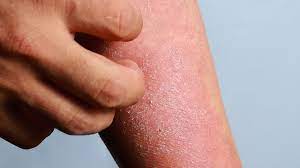Dermatitis
 The term “dermatitis” is used to describe a variety of rashes and skin irritations that can be brought on by irritants, infections, allergies, overactive immune systems, heredity, and more. Dry skin, redness, and itching are typical signs.
The term “dermatitis” is used to describe a variety of rashes and skin irritations that can be brought on by irritants, infections, allergies, overactive immune systems, heredity, and more. Dry skin, redness, and itching are typical signs.
In the word “dermatitis,” “derm” stands for “skin” and “itis” for “inflammation.” The phrase as a whole refers to “skin inflammation.” Depending on the source, the rashes can be minor to severe and result in a number of issues.
Skin rashes don’t seriously hurt your health. It does not indicate that your skin is dirty or sick, nor is it contagious.
SYMPTOMS
The symptoms depend on the type of dermatitis. You may have one type, or you may have several. Each type may have one or more of the following symptoms:
- Red rashes and bumps.
- Rashes that look and/or feel like a burn.
- Dry skin.
- Fluid-filled blisters.
- Thickening, hardening and swelling skin.
- Crusting, scaling and creasing skin.
- Painful ulcers.
- When scratched, the rashes may ooze fluid or bleed.
Here are examples of signs and symptoms of common types of dermatitis:
Atopic dermatitis (eczema): Atopic dermatitis happens when there is damage to the skin barrier. This causes the skin to become inflamed, red, dry, bumpy and itchy.
Contact dermatitis: Contact dermatitis is an allergic or irritant reaction that causes a painful or itchy skin rash. As the name suggests, you get contact dermatitis from coming into contact with an allergen. Examples include an allergen like poison ivy and an irritant like a chemical.
Cradle cap (infant seborrhea dermatitis): Cradle cap is a harmless skin condition on the scalp of a baby that appears as yellow scaly patches surrounded by a red rash.
Diaper dermatitis (rash): As the name suggests, diaper dermatitis is when a rash appears on any part of a baby’s skin covered by a diaper. The skin gets broken down by wetness, movement and waste products.
Dyshidrotic dermatitis: This type of dermatitis causes itchy blisters on the edges of your fingers, palms, toes and the soles of your feet. The blisters can be painful.
CAUSES
Dermatitis is caused by a combination of immune system activation, genetics and environmental triggers.
Immune system: Sometimes your immune system overreacts. If you have atopic dermatitis, your immune system reacts to seemingly small irritants or allergens. This causes inflammation.
Genetics: If others in your family have dermatitis, you’re more likely to have it. Additionally, experts have identified changes to genes that control a protein that helps your body maintain healthy skin. Your skin cannot remain healthy without normal levels of that protein.
Environment: Your immune system may be influenced by your environment to alter your skin’s barrier of defense. More moisture escapes as a result, which can cause dermatitis. Exposure to air pollution and tobacco smoke are two examples of potential environmental causes. It’s also possible to find fragrances in some soaps and skincare products.
Exposure: Chemical and other irritating exposure can result in some kinds of dermatitis. For instance, fluoride exposure from water or toothpaste might result in Perioral dermatitis.
PREVENTION
Try to stay away from the things that cause your dermatitis. This could include foods to which you are sensitive or allergic, as well as soaps and chemicals that irritate your skin. Regularly moisturize your skin. Don’t become too hot. To prevent the air from becoming too dry, use a humidifier. Don’t scratch, please. Become less stressed.
